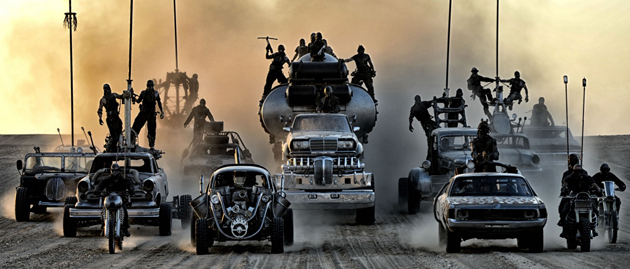Colin Gibson

AS: What was the process for creating one of the vehicles? After those initial storyboards would there be more detailed sketches done and then a trip to a scrapyard to find matching pieces?
CG: No, we inverted it. What I try to do with any job is to design the design process first. For this design process we decided we’d be true to the Wasteland. We designed the way they would have. We did the salvage first, asking, What are we looking for and why are we keeping it? That way we managed to get rid of the last forty years or so of the automobile universe because nobody wants to go into battle with a piece of carbon fiber Japanese technology. Nobody wants to go in with computerized engines that you can no longer fix with a stick and some bubblegum. And nobody wants to bother saving anything that’s as ugly as a Camry or a Corolla.
We figured the War Boys of the Wasteland had their own preoccupations. One of them was the guilt that you might feel at the end of civilization. There’s all this great flotsam and jetsam washed up on the edge of the Wasteland that you’re salvaging scraps from, that you just know must have been fantastic. This was one of the reasons that we worked in the theory that just because it’s the end of the world doesn’t mean that you don’t try to make something beautiful. You try to re-purpose something that you know is beautiful even if it’s out of context. Maybe it’s just me but the tailfin of a ‘59 Cadillac is always going to be something worth salvaging.
AS: I heard you would avoid aging the vehicles with a lot of rust.
CG: Rust was one of the arguments that George and I had, because I am a great lover of rust and patina and history like every other tragic, sentimental art director. We love that post-industrial falling-apart look. But George was nervous about going back to what he’d already done in the first movies and what had been devalued by decades of b-grade genre- the idea that you merely had to weld a piece of barbwire to a Camaro and call it the apocalypse.
Given our color palette we didn’t want to go with the obvious bleach-bypass route. We let history and the world add a new fetish and bleach it for us. By going with beaten metal we kept a lot of the color out. We pared back a lot of the patina and rust but still kept it as a little bass-note. One of the things I wanted was black and given that there was no paint left we discovered that there was a beautiful sludge byproduct of petroleum cracking. We re-purposed that as something to plaster over the rusted metal of some of the vehicles. A lot of the Citadel vehicles that are black are actually an inch or two of this lovely thick, black pitch. And it also meant that we could smear in skulls and doll’s heads and guns and assorted other fetishes. It also was logistically a wondrous thing. When you have the same War Rig going out for a hundred-and-forty-eight days and have it slammed into by eighty or ninety other vehicles it’s handy not having to re-panel it every night. Instead you just smear some more of the black pitch over the top and then buff it back to continuity.